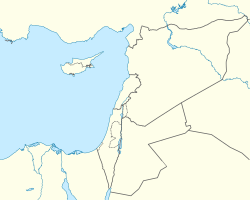
Back Dimasq ACE Дамаск ADY Damaskus Afrikaans Damaskus ALS ደማስቆ Amharic Domás AN Damascus ANG Damasikọs ANN دمشق Arabic ܕܪܡܣܘܩ ARC
Damascus
دِمَشق | |
|---|---|
 Umayyad Mosque General view of Damascus • Mount Qasioun Maktab Anbar • Azm Palace Sulaymaniyya Takiyya | |
| Nicknames: | |
| Coordinates: 33°30′47″N 36°17′31″E / 33.51306°N 36.29194°E | |
| Country | |
| Governorate | Damascus Governorate, Capital City |
| First settled | unknown |
| Municipalities | 16 |
| Government | |
| • Type | Mayor–council government[4] |
| • Governor | Mohammad Tariq Kreishati[5] |
| Area | |
| • Metropolis | 105 km2 (41 sq mi) |
| • Urban | 77 km2 (29.73 sq mi) |
| Elevation | 680 m (2,230 ft) |
| Population (2022 estimate) | |
| • Rank | 1st in Syria 15th in the Arab World |
| • Urban | 2,503,000[8] |
| • Urban density | 24,000/km2 (60,000/sq mi) |
| • Metro | 2,685,000[7] |
| • Metro density | 7,090/km2 (18,400/sq mi) |
| Demonyms | English: Damascene Arabic: دِمَشقِيّ, romanized: Dimašqī |
| Time zone | UTC+3 (AST) |
| Postal code | 0100 |
| Area code(s) | Country code: 963, City code: 11 |
| Geocode | C1001 |
| ISO 3166 code | SY-DI |
| Climate | BWk |
| HDI (2021) | 0.612[9] – medium |
| International airport | Damascus International Airport |
| Website | www |
| Official name | Ancient City of Damascus |
| Type | Cultural |
| Criteria | i, ii, iii, iv, vi |
| Designated | 1979 (3rd session) |
| Reference no. | 20 |
| Region | Arab States |
Damascus (/dəˈmæskəs/ də-MAS-kəs, UK also /dəˈmɑːskəs/ də-MAH-skəs; Arabic: دِمَشق, romanized: Dimašq) is the capital and largest city of Syria, the oldest current capital in the world and, according to some, the fourth holiest city in Islam.[10][11][12] Known colloquially in Syria as aš-Šām (الشَّام) and dubbed, poetically, the "City of Jasmine" (مَدِيْنَةُ الْيَاسْمِينِ Madīnat al-Yāsmīn),[1] Damascus is a major cultural center of the Levant and the Arab world.
Situated in southwestern Syria, Damascus is the center of a large metropolitan area. Nestled among the eastern foothills of the Anti-Lebanon mountain range 80 kilometres (50 mi) inland from the eastern shore of the Mediterranean on a plateau 680 metres (2,230 ft) above sea level, Damascus experiences an arid climate because of the rain shadow effect. The Barada River flows through Damascus.
Damascus is one of the oldest continuously inhabited cities in the world.[13] First settled in the 3rd millennium BC, it was chosen as the capital of the Umayyad Caliphate from 661 to 750. After the victory of the Abbasid dynasty, the seat of Islamic power was moved to Baghdad. Damascus saw its importance decline throughout the Abbasid era, only to regain significant importance in the Ayyubid and Mamluk periods.
Today, it is the seat of the central government of Syria. As of September 2019[update], eight years into the Syrian civil war, Damascus was named the least livable city out of 140 global cities in the Global Liveability Ranking.[14] As of June 2023[update], it was the least livable out of 173 global cities in the same Global Liveability Ranking. In 2017, two new development projects have been launched in Damascus to build new residential districts, Marota City and Basillia City to symbolize post-war reconstruction.[15]
- ^ a b "Biggest Cities In Syria". 25 April 2017. Archived from the original on 25 October 2019. Retrieved 25 October 2019.
- ^ Cite error: The named reference
Damascuswas invoked but never defined (see the help page). - ^ Almaany Team. "معنى كلمة الفَيْحَاءُ في معجم المعاني الجامع والمعجم الوسيط – معجم عربي عربي – صفحة 1". almaany.com. Retrieved 24 October 2017.[dead link]
- ^ "Damascus Administration and society". 3 August 2024.
- ^ "President al-Assad issues decrees on appointing new governors for eight Syrian provinces". SANA. 20 July 2022. Archived from the original on 20 July 2022. Retrieved 10 August 2022.
- ^ Albaath.news statement by the governor of Damascus, Syria Archived 16 May 2011 at the Wayback Machine (in Arabic), April 2010
- ^ "Damascus metro population 2022". macrotrends.net. Retrieved 23 September 2022.
- ^ "Damascus population 2022". World Population Review. Archived from the original on 2 October 2022. Retrieved 23 September 2022.
- ^ Sub-national HDI. "Area Database – Global Data Lab". hdi.globaldatalab.org.
- ^ Dumper, Michael R. T.; Stanley, Bruce E. (2007). "Damascus". In Janet L. Abu-Lughod (ed.). Cities of the Middle East and North Africa: A Historical Encyclopedia. ABC-CLIO. pp. 119–126. ISBN 978-1-5760-7919-5. Archived from the original on 2 April 2023. Retrieved 12 May 2021.
- ^ Sarah Birke (2 August 2013), Damascus: What's Left, New York Review of Books, archived from the original on 4 December 2018, retrieved 12 May 2021
- ^ Totah, Faedah M. (2009). "Return to the origin: negotiating the modern and unmodern in the old city of Damascus". City & Society. 21 (1): 58–81. doi:10.1111/j.1548-744X.2009.01015.x.
- ^ Bowker, John (1 January 2003), "Damascus", The Concise Oxford Dictionary of World Religions, Oxford University Press, doi:10.1093/acref/9780192800947.013.1793 (inactive 1 November 2024), ISBN 978-0-19-280094-7, archived from the original on 7 April 2022, retrieved 15 January 2021
{{citation}}: CS1 maint: DOI inactive as of November 2024 (link) - ^ Buckley, Julia (4 September 2019). "World's most livable city revealed". CNN Travel. Archived from the original on 15 September 2019. Retrieved 23 September 2019.
- ^ "A luxury city shows blueprint for Syria's rebuilding plans". AP News. 5 November 2018. Retrieved 7 June 2024.
Cite error: There are <ref group=note> tags on this page, but the references will not show without a {{reflist|group=note}} template (see the help page).




